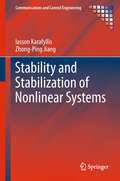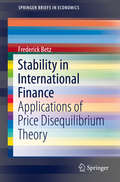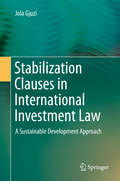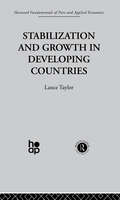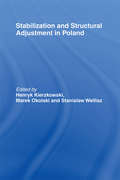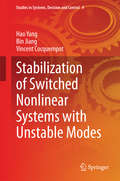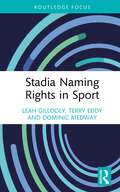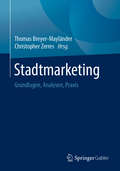- Table View
- List View
Stabilising Capitalism: A Greater Role for Central Banks (Palgrave Macmillan Studies in Banking and Financial Institutions)
by Pierluigi CioccaStabilising Capitalism.
Stabilising Capitalism: A Greater Role for Central Banks (Palgrave Macmillan Studies in Banking and Financial Institutions)
by Pierluigi CioccaThe role of central banks as a hinge on which the financial system rests has returned to the top of the political agenda in recent years. The global financial crisis has resulted in many changes for central banks, including renewed power in financial supervision and reduced restrictions in their implementation of monetary policies. This book argues that central banks play a key role in financial systems, presenting the European Central Bank as a specific example of an institution that uses its uniquely independent position and wide margins of discretion to provide an array of important functions. It illustrates how central banks promote the security and efficiency of payment systems, pursue price stability, and accommodate the optimal utilization of the resources, labour and capital available to an economy. Stabilising Capitalism demonstrates how these institutions also aid in dealing with the risk of financial collapse and permit the continuity of public expenditure when the government is unable to place securities in the bond market. The author concludes by suggesting that although many consider the idea of this role for central banks to be outdated, these institutions form the root of the capitalist market economy and act as a bastion against financial instability.
Stability and Change in High-Tech Enterprises: Organisational Practices in Small to Medium Enterprises (Routledge Studies in Business Organizations and Networks)
by Neil CostelloHow do firms live through and experience change? The authors examine four high-technology firms, providing a rich analysis of their routines, and illustrating how people are continually engaged with change. The book develops a broader concept of routine, and identifies the persistence of routine practices at a strategic level.
Stability and Stabilization of Nonlinear Systems
by Zhong-Ping Jiang Iasson KarafyllisRecently, the subject of nonlinear control systems analysis has grown rapidly and this book provides a simple and self-contained presentation of their stability and feedback stabilization which enables the reader to learn and understand major techniques used in mathematical control theory. In particular: the important techniques of proving global stability properties are presented closely linked with corresponding methods of nonlinear feedback stabilization; a general framework of methods for proving stability is given, thus allowing the study of a wide class of nonlinear systems, including finite-dimensional systems described by ordinary differential equations, discrete-time systems, systems with delays and sampled-data systems; approaches to the proof of classical global stability properties are extended to non-classical global stability properties such as non-uniform-in-time stability and input-to-output stability; and new tools for stability analysis and control design of a wide class of nonlinear systems are introduced. The presentational emphasis of Stability and Stabilization of Nonlinear Systems is theoretical but the theory's importance for concrete control problems is highlighted with a chapter specifically dedicated to applications and with numerous illustrative examples. Researchers working on nonlinear control theory will find this monograph of interest while graduate students of systems and control can also gain much insight and assistance from the methods and proofs detailed in this book.
Stability and Stabilization of Nonlinear Systems
by Zhong-Ping Jiang Iasson KarafyllisRecently, the subject of nonlinear control systems analysis has grown rapidly and this book provides a simple and self-contained presentation of their stability and feedback stabilization which enables the reader to learn and understand major techniques used in mathematical control theory. In particular: the important techniques of proving global stability properties are presented closely linked with corresponding methods of nonlinear feedback stabilization; a general framework of methods for proving stability is given, thus allowing the study of a wide class of nonlinear systems, including finite-dimensional systems described by ordinary differential equations, discrete-time systems, systems with delays and sampled-data systems; approaches to the proof of classical global stability properties are extended to non-classical global stability properties such as non-uniform-in-time stability and input-to-output stability; and new tools for stability analysis and control design of a wide class of nonlinear systems are introduced. The presentational emphasis of Stability and Stabilization of Nonlinear Systems is theoretical but the theory's importance for concrete control problems is highlighted with a chapter specifically dedicated to applications and with numerous illustrative examples. Researchers working on nonlinear control theory will find this monograph of interest while graduate students of systems and control can also gain much insight and assistance from the methods and proofs detailed in this book.
Stability in International Finance
by Frederick BetzThis book aims to explore stability in an international financial system using disequilibrium theory. It examines historical cases of both instability and stability and reviews price-disequilibrium theory to construct a theoretical model for a stable international financial system. In the modern knowledge economy in a global world, financial socio-technical systems still continue to be central to global commerce. Moreover, technological advances in computer and communications have changed both the knowledge economy and the financial system. While globalization and technology have made international finance more powerful and important to knowledge economies, they have also increased the volatility, instability, and fraudulent use of international finance. The international world has not experienced a long-term, stable financial system after 1913. International financial systems have been periodically unstable, triggering financial crises and resultant economic depressions in different nations. Yet the global economy cannot develop properly without a stable international system, which distributes wealth to economically productive activities. How then can a stable and modern international-financial-system be constructed? In this provocative volume, the authors applies the cross-disciplinary analysis of societal dynamics to important economic writers to derive a new approach to the problem of stabilizing international financial systems.
Stabilization Clauses in International Investment Law: A Sustainable Development Approach
by Jola GjuziThis book analyzes the tension between the host state’s commitment to provide regulatory stability for foreign investors – which is a tool for attracting FDI and generating economic growth – and its evolving non-economic commitments towards its citizens with regard to environmental protection and social welfare. The main thesis is that the ‘stabilization clause/regulatory power antinomy,’ as it appears in many cases, contradicts the content and rationale of sustainable development, a concept that is increasingly prevalent in national and international law and which aims at the integration and balancing of economic, environmental, and social development. To reconcile this antinomy at the decision-making and dispute settlement levels, the book employs a ‘constructive sustainable development approach,’ which is based on the integration and reconciliation imperatives of the concept of sustainable development as well as on the application of principles of law such as non-discrimination, public purpose, due process, proportionality, and more generally, good governance and rule of law. It subsequently re-conceptualizes stabilization clauses in terms of their design (ex-ante) and interpretation (ex-post), yielding stability to the benefit of foreign investors, while also mitigating their negative effects on the host state’s power to regulate.
Stabilization and Growth in Developing Countries: A Structuralist Approach
by L. TaylorLance Taylor uses structuralist models to examine the issues of short-term fluctuations and long-term growth in developing economies.
Stabilization and Reconstruction Staffing
by Terrence K. Kelly Thomas S. Szayna Deanna Weber Prine Ellen E. TunstallUses the Office of Personnel Management's Human Capital Assessment and Accountability Framework, which advocates strategic alignment, workforce planning and development, and leadership and knowledge management, to assess the U.S. civilian personnel and staffing requirements for stability and reconstruction operations.
Stabilization and Reform in Latin America: A Macroeconomic Perspective of the Experience Since the 1990s
by Anoop SinghThis study examines external and domestic influences on Latin America's economic performance over the past decade and a half. It notes that over the past few years, macroeconomic policies have strengthened and structural reforms have been implemented. Together with a favorable external environment, these policies have contributed to Latin America's relatively sharp economic recovery from its last recession. The study discusses the priorities for the region's reform agenda that could help to ensure that this growing prosperity becomes entrenched. It also makes observations on the future roles of the major policymakers involved-the governments in the region; the international financial institutions, and especially the IMF; and industrial country governments.
Stabilization and Structural Adjustment in Poland
by Henryk Kierzkowski Marek Okolski Stanislaw WelliszThe Solidarity-led government which came into power in Poland in Autumn 1989 faced two enormous tasks. First, to stabilize an economy prone to hyperflation. Second, to replace a crumbling command system in favour of a market mechanism, in a country whose market institutions had been destroyed under forty years of communist rule. This book recounts the events of this period and the course taken by the new government, and analyzes the significance of this for the transition process in Poland and elsewhere.
Stabilization and Structural Adjustment: Macroeconomic Frameworks for Analysing the Crisis in Sub-Saharan Africa
by Finn TarpThis book reveals and examines the relevance of the macroeconomic theory and models behind recommendations for stabilization and structual adjustment. Alternaive analytical approaches are discusses. This is done on the basis of an up-to-date review of developments in sub-saharan Africa during the 1980's and within a common analytical framework.
Stabilization and Structural Reform in the Czech and Slovak Federal Republic: First Stage
by Eduardo Borensztein Tessa van der Willigen Bijan B. AghevliOn January 1, 1991, the Czech and Slovak Federal Republic launched a comprehensive reform program designed to establish a market economy. This paper charts the progress of the reform program in the context of Czechoslovakia's prewar history as a major industrial power, its subsequent slow economic decline under Communism, and its recent integration into the world economy following the collapse of the Council for Mutual Economic Assistance.
Stabilization of Switched Nonlinear Systems with Unstable Modes
by Hao Yang Bin Jiang Vincent CocquempotThis book provides its reader with a good understanding of the stabilization of switched nonlinear systems (SNS), systems that are of practical use in diverse situations: design of fault-tolerant systems in space- and aircraft; traffic control; and heat propagation control of semiconductor power chips. The practical background is emphasized throughout the book; interesting practical examples frequently illustrate the theoretical results with aircraft and spacecraft given particular prominence. Stabilization of Switched Nonlinear Systems with Unstable Modes treats several different subclasses of SNS according to the characteristics of the individual system (time-varying and distributed parameters, for example), the state composition of individual modes and the degree and distribution of instability in its various modes. Achievement and maintenance of stability across the system as a whole is bolstered by trading off between individual modes which may be either stable or unstable or by exploiting areas of partial stability within all the unstable modes. The book can be used as a reference for academic research on switched systems or used by graduate students of control theory and engineering. Readers should have studied linear and nonlinear system theory and have some knowledge of switched and hybrid systems to get the most from this monograph.
Stacked: Your Super-Serious Guide to Modern Money Management
by Emily Guy Birken Joe Saul-SehyFrom the money nerds behind the award-winning Stacking Benjamins podcast, a new kind of personal finance book to get your house in order. Rich. Wealthy. Well-heeled. Moneyed. Affluent. Not bad—but why not get Stacked instead? If you&’ve ever dreamed of a basic philosophy of money that&’ll help you live bigger, be bolder, and laugh harder, you need this book. In these uncertain times, the basics matter more than ever. But for most of us, concepts such as investing, budgeting, and getting out of debt just don&’t float our boats (or 150-foot yachts)—and so we put them off longer than we should. Joe Saul-Sehy and Emily Guy Birken are here to tell you that personal finance can be a lot more fun than you think. (No haberdashery, maritime knowledge, or specialized flatware required.) Learn about everything from side hustles, to hiring a legit financial adviser, to planning for emergencies, to what&’s new and exciting—and actually worth your time—in financial apps and software. If you&’re looking for the same old get-rich-quick clichés, avocado toast shaming, or alphabet soup of incomprehensible financial terms, you won&’t find them here. Instead, Saul-Sehy and Birken take you step by step along the way to financial success, with their signature blend of shrewd financial information and wacky humor.
Stacking the Deck
by David S. PottruckChange is a constant, and leaders must do more than keep up--they must innovate and accelerate to succeed. Yet people are often unnerved by change. As a leader during a time of transformation, you may stand up before teams that are indifferent, or even hostile, and need to convince them that change is necessary and urgent. More than money, time, or resources, the ability to lead these people determines your ultimate success or failure. What does it take to be an effective change leader and increase the odds of success?Stacking the Deck offers a proven, practical approach for inspiring meaningful, lasting change across an organization. Stacking the Deck presents a nine-step course of action leaders can follow from the first realization that change is needed through all the steps of implementation, including assembling the right team of close advisors and getting the word out to the wider group.Based on Dave Pottruck's experiences leading change as CEO of Charles Schwab and later as chairman of CorpU and HighTower Advisors, these steps provide a guide to ensure that your change initiative and your team have the best possible shot at success. In addition, established business leaders who have led extraordinary change initiatives demonstrate the steps in action. These executives include eBay CEO John Donahoe, Wells Fargo former CEO Dick Kovacevich, Starbucks chief executive officer Howard Schultz, San Francisco Giants CEO Larry Baer, JetBlue CEO Dave Barger, Asurion CEO Steve Ellis, Pinkberry CEO Ron Graves, and Intel's President Renee James, among others.Leading an organization through major change--whether it's the introduction of a new product, an expansion to a new territory, or a difficult downsizing--is not for the faint of heart. While success is never guaranteed, the right leadership, process, and team make all the difference. For all leaders facing major change in their organizations, Stacking the Deck is an indispensable resource for putting the odds in your favor.
Stadia Naming Rights in Sport (Sport Business Insights)
by Dominic Medway Leah Gillooly Terry EddyThis book is an accessible, practical, and systematic guide to stadium naming rights sponsorship within sport, designed to help practitioners and students gain a better understanding of how naming rights work and the benefits that sport and corporate organisations may get from this kind of arrangement. The book explains the key principles underpinning naming rights deals and sports sponsorship in non-specialist language for readers with little prior knowledge of the subject. Drawing on examples and case studies of naming rights sponsorships in international markets, across both professional and amateur sport, the book examines key practical issues such as how naming rights differ from other types of sponsorship, why brands should sign a naming rights deal, and how organisations can maximise their return on naming rights sponsorship. Concise, informative, and practice-focused, this book offers essential insights for all sport management practitioners, for any marketing executives considering sport sponsorship, and for any students or researchers with an interest in sport marketing, sport management, marketing, or events and facilities management.
Stadium City: Sports and Media Infrastructure in the United States (Studies in Sports Media)
by Helen Morgan ParmettA new sports stadium has an outsized impact on a city’s landscape and image of itself. Each stadium also plays a central role in media institutions, technologies, and culture as a catalyst for urban change and flashy neighborhood anchor, cornerstone of regional identity and purveyor of multimedia experiences. Helen Morgan Parmett analyzes sports stadiums in Atlanta, Seattle, and Minneapolis to demonstrate the role that media institutions, technologies, and culture play in sports and examine their impact on the urban landscape. These interconnected factors impact struggles over city space, identity, and urban governing. As Morgan Parmett shows, stadiums exist as more than just buildings and sporting places—they are central nodes in the city that connect, disconnect, and distribute resources, people, information, and, ultimately, power. Morgan Parmett demonstrates how the “sportification” of place is influenced by the specific histories, geography, and sporting cultures of a city while explaining their relationship to broader forces at work in media, sport, and urbanism. Original and incisive, Stadium City offers a beyond-the-playing-field analysis of sports stadiums and their impact on our cities and our lives.
Stadtentwicklung mit einem Developer Mindset: Innovation, Wachstum und Wettbewerbsfähigkeit in kritischen Zeiten
by Heiko AchillesIn einer Zeit großer globaler Herausforderungen und technologischer Disruptionen stehen Städte im Fokus des Wandels, sie sind Möglichkeitsräume und Reallabore. Dieses Buch bietet eine praxisnahe Orientierung in dem komplexen Gefüge aus Wirtschafts- und Stadtentwicklung. Der Autor liefert kritische Analysen aktueller Debatten und stellt effektive Strategien für mehr Wettbewerbsfähigkeit und Nachhaltigkeit vor. In dem Buch geht es um strategische Planung, um hilfreiche Strukturen und Prozesse - und den erforderlichen, erfolgsbestimmenden Mindset. Die aktuelle Situation in Deutschland wird mit internationalen Beispielen verglichen, nach erfolgreichen und übertragbaren Lösungsansätzen gesucht. Das Buch richtet sich an Fachleute und Entscheidungsträger aller Disziplinen der Stadtentwicklung sowie an alle, die sich für die Zukunft der Städte interessieren.
Stadtmarketing: Grundlagen, Analysen, Praxis
by Thomas Breyer-Mayländer Christopher ZerresStadtmarketing ist das Aufgabenfeld verschiedener Disziplinen und Berufsgruppen. Neben Marketingfachleuten aus Wissenschaft, Beratung und Praxis beschäftigt es auch Verwaltungsexperten oder Praktiker aus Handel und Gastronomie. Voraussetzung und Basis für erfolgreiche Marketingstrategien ist daher eine interdisziplinäre, konstruktive und flexible Zusammenarbeit aller Beteiligten. Dieses Buch gibt einen Überblick über die Grundlagen des Stadtmarketing und liefert Ansatzpunkte für die Weiterentwicklung von Städten, Kommunen und Regionen. Es beleuchtet die wichtigen Aspekte Transformation, Mobilität und Infrastruktur und bietet gezielte Anregungen für die Marketingpraxis. Zudem werden Beispiele erfolgreicher praktischer Umsetzungen aufgezeigt, wie etwa in Freiburg, Frankfurt, Neumünster, Offenburg, Jena, Mainz oder Leipzig.Über 40 renommierte Branchenexperten beschreiben, was die Branche bewegt und was es in Zukunft zu beachten gilt. Das Werk bietet Neulingen und Quereinsteigern aus anderen Fachgebieten sowie Studierenden großen Nutzwert. Außerdem enthält es wegweisende Anregungen für erfahrene Praktiker, die die Kommunikation und Kooperation mit Stakeholdern aus unterschiedlichen Fachdisziplinen verbessern möchten und zugleich nach Impulsen für die eigene Arbeit suchen.
Stadtverkehrsplanung Band 1: Grundlagen, Ziele und Perspektiven
by Walter Vogt Barbara Engel Dirk ValléeDas dreibändige Standardwerk behandelt alle wesentlichen Probleme und Lösungsansätze des Stadtverkehrs. Unter Einbindung von Mobilität und Verkehr in die Stadtentwicklungsplanung geht es um Grundlagen, Ziele und Perspektiven der Planung, um Analyse und Prognose der Verkehrsentwicklung mit Hilfe von Szenarien und Modellen, um Abschätzung der Wirkungen des Verkehrs auf die humane und natürliche Umwelt einschließlich der Bewertung sowie um Bemessung, Gestaltung und Entwurf und Betrieb städtischer Verkehrsanlagen (Verkehrsmanagement und Lichtsignalsteuerung). Neue Kapitel – z.B. Mobilitätsmanagement, Multimodalität oder urbane Logistik – nehmen aktuelle Entwicklungen auf.Der erste Band des dreibändigen Fachbuchs stellt die Grundlagen, Ziele und Perspektiven der Stadtverkehrsplanung vor. Inhalte sind die Planungsgrundlagen, planungsrechtliche Verfahren, Leitbilder und neue Perspektiven für die urbane Logistik sowie zukünftige Trends im Stadtverkehr.
Stadtverkehrsplanung Band 2: Analyse, Prognose und Bewertung
by Walter Vogt Barbara Engel Dirk ValléeDas dreibändige Standardwerk behandelt alle wesentlichen Probleme und Lösungsansätze des Stadtverkehrs. Unter Einbindung von Mobilität und Verkehr in die Stadtentwicklungsplanung geht es um Grundlagen, Ziele und Perspektiven der Planung, um Analyse und Prognose der Verkehrsentwicklung mit Hilfe von Szenarien und Modellen, um Abschätzung der Wirkungen des Verkehrs auf die humane und natürliche Umwelt einschließlich der Bewertung sowie um Bemessung, Gestaltung und Entwurf und Betrieb städtischer Verkehrsanlagen (Verkehrsmanagement und Lichtsignalsteuerung). Neue Kapitel – z.B. Mobilitätsmanagement, Multimodalität oder urbane Logistik – nehmen aktuelle Entwicklungen auf.Der zweite Band des dreibändigen Werks präsentiert verschiedene Analyse- und Prognoseverfahren der Stadtverkehrsplanung sowie Grundlagen der Dimensionierung und Bewertung. Betrachtet werden Verkehrserhebungen, Nachfragemodelle des Personenverkehrs, Modelle und Strategien des Güterverkehrs, Umweltwirkungen, ökologische und städtebauliche Folgen ebenso wie partizipative Verfahren.
Stadtverkehrsplanung Band 3: Entwurf, Bemessung und Betrieb
by Walter Vogt Barbara Engel Dirk ValléeDas dreibändige Standardwerk behandelt alle wesentlichen Probleme und Lösungsansätze des Stadtverkehrs. Unter Einbindung von Mobilität und Verkehr in die Stadtentwicklungsplanung geht es um Grundlagen, Ziele und Perspektiven der Planung, um Analyse und Prognose der Verkehrsentwicklung mit Hilfe von Szenarien und Modellen, um Abschätzung der Wirkungen des Verkehrs auf die humane und natürliche Umwelt einschließlich der Bewertung sowie um Bemessung, Gestaltung und Entwurf und Betrieb städtischer Verkehrsanlagen (Verkehrsmanagement und Lichtsignalsteuerung). Neue Kapitel – z.B. Mobilitätsmanagement, Multimodalität oder urbane Logistik – nehmen aktuelle Entwicklungen auf.Der dritte Band des dreibändigen Fachbuchs beschreibt Bemessung, Entwurf und Gestaltung sowie Betrieb der städtischen Verkehrsinfrastruktur. Gegenstand sind die Netzplanung, Anlagen des motorisierten Individualverkehrs, der öffentliche Personennahverkehr, die Nahmobilität, die Verkehrssicherheit sowie Verkehrsmanagement und Lichtsignalsteuerung.
Staff Appraisal and Development (Routledge Library Editions: Human Resource Management)
by Clive Fletcher James Walker Edgar AnsteyOrganisations of all kinds have invested a great deal of time and effort in staff appraisal and management development, continually re-defining their aims and methods. This book, first published in 1976, reviews the progress made by 17 organisations in both public and private sectors. It presents the findings of an extensive series of research studies that assess the effectiveness of appraisal interviews and identify the factors contributing to their success or failure. Looking beyond appraisal, further measures needed to increase job satisfaction and efficiency are outlined. These include more systematic career development plans for all staff and fresh initiatives to secure their more active participation in the appraisal process. This title will be of interest to those who are concerned in management, and those studying business studies and human resource management.



